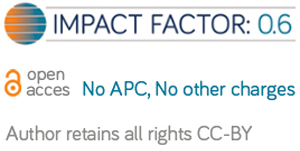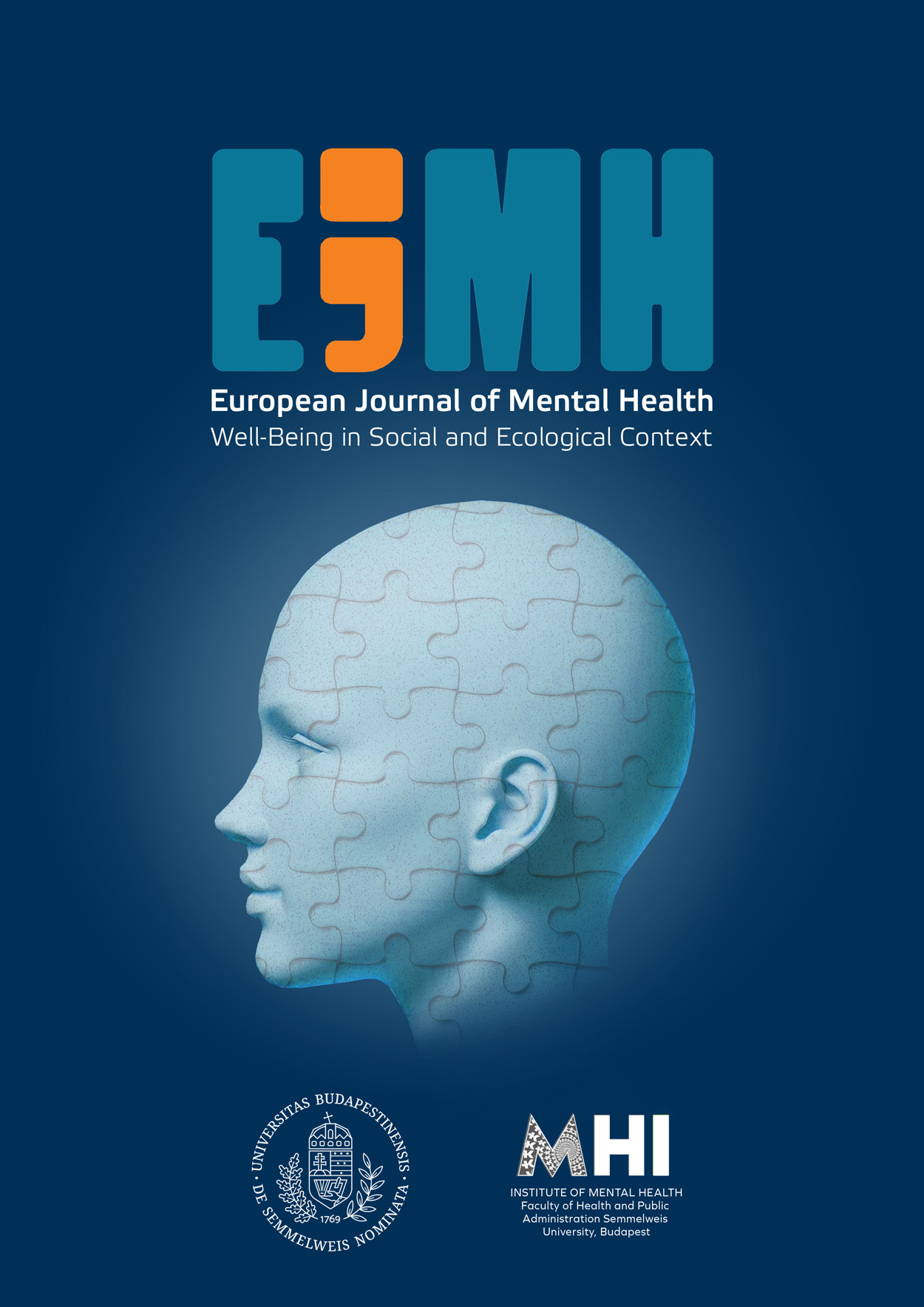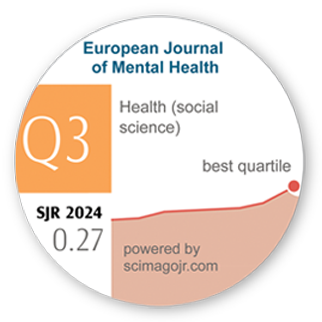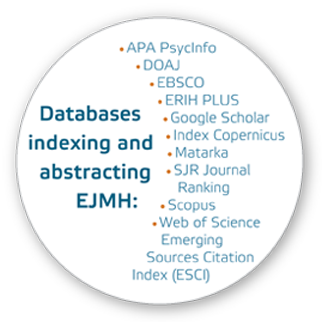Moral Suffering in Frontline Social Care Workers: A Study of Moral Injury and Moral Distress
DOI:
https://doi.org/10.5708/EJMH.19.2024.0021Keywords:
moral suffering, moral injury, moral distress, social care, frontline workersAbstract
Introduction: Moral suffering (MS) is psycho-emotional harm derived from a conflict between one’s circumstances and one’s deeply held moral values. It includes the constructs of moral distress (MD) and moral injury (MI) and is characterized by constraints or mandates preventing the perceived morally correct event. Evidence has demonstrated the application of MS in helping professions, and research has linked MS to a deterioration of mental health, self-identity, worldview, and job-performance.
Aims: In this study, we examined the relationship between MD, MI, burnout, and external/internal constraints in Frontline Social Care Workers (FSCWs) in the UK.
Methods: We employed a quantitative, cross-sectional correlational design, recruiting 119 FSCWs (female = 91.6%, tenure 1–2 years = 27.4%) using convenience sampling. Participants completed an online survey including the Moral Injury Events Scale and the Copenhagen Burnout Inventory. Measures for MD, external constraints (stress, time, and resources), and internal constraints (psychological safety and preparedness) were informed by previous research.
Results: Participants reported a significant prevalence of moderate-to-high MD (25.4%), MI (33.3%), and burnout (64.9%), and we found significant relationships between the constructs and dimensions. Constraints were significant predictors of MS (explaining 35.3% of MD variance and 30.1% of MI variance), with stress, time, and psychological safety making the strongest contributions.
Conclusions: FSCWs can be examined as a unitary population experiencing morally challenging circumstances that may result in MS and burnout. Improved MS measures, increased awareness, and policy shifts are necessary to redefine the paradigm of work-related distress, taking systemic constraints and the potential for moral harm into account.
References
Ashcroft, R., Sur, D., Greenblatt, A., & Donahue, P. (2022). The Impact of the COVID-19 pandemic on social workers at the frontline: A survey of Canadian social workers. The British Journal of Social Work, 52 (3), 1724–1746.
https://doi.org/10.1093/bjsw/bcab158
Atli Özbaş, A., Kovanci, M. S., & Köken, A. H. (2021). Moral distress in oncology nurses: A qualitative study. European Journal of Oncology Nursing, 54, Article 102038.
https://doi.org/10.1016/j.ejon.2021.102038
Baele, C. A., & Fontaine, J. R. J. (2021). The Moral Distress‐Appraisal Scale: Scale development and validation study. Journal of Advanced Nursing, 77(10), 4120–4130.
https://doi.org/10.1111/jan.14923
Bartlett, M. S. (1954). A note on the multiplying factors for various χ2 approximations. Journal of the Royal Statistical Society: Series B (Methodological), 16(2), 296–298.
https://doi.org/10.1111/j.2517-6161.1954.tb00174.x
Belrhiti, Z., Van Damme, W., Belalia, A., & Marchal, B. (2019). Does public service motivation matter in Moroccan public hospitals? A multiple embedded case study. International Journal for Equity in Health, 18, Article 160.
https://doi.org/10.1186/s12939-019-1053-8
BMA. (2021). Moral distress and moral injury Recognising and tackling it for UK doctors.
https://www.bma.org.uk/media/4209/bma-moral-distress-injury-survey-report-june-2021.pdf
Braxton, J. M., Busse, E. M., & Rushton, C. H. (2021). Mapping the terrain of moral suffering. Perspectives in Biology and Medicine, 64(2), 235–245.
https://doi.org/10.1353/pbm.0.0029
Briggs, S. R., & Cheek, J. M. (1986). The role of factor analysis in the development and evaluation of personality scales. Journal of Personality, 54(1), 106–148.
https://doi.org/10.1111/j.1467-6494.1986.tb00391.x
Bryan, C. J., Bryan, A. O., Anestis, M. D., Anestis, J. C., Green, B. A., Etienne, N., Morrow, C. E., & Ray-Sannerud, B. (2016). Measuring moral injury: Psychometric properties of the Moral Injury Events Scale in two military samples. Assessment, 23(5), 557–570.
https://doi.org/10.1177/1073191115590855
Butler Institute for Families. (2009). Preparedness for work [Unpublished measure]. University of Denver.
Campbell, S. M., Ulrich, C. M., & Grady, C. (2016). A broader understanding of moral distress. The American Journal of Bioethics, 16(12), 2–9.
https://doi.org/10.1080/15265161.2016.1239782
Čartolovni, A., Stolt, M., Scott, P. A., & Suhonen, R. (2021). Moral injury in healthcare professionals: A scoping review and discussion. Nursing Ethics, 28(5), 590–602.
https://doi.org/10.1177/0969733020966776
Choe, K., Kang, Y., & Park, Y. (2015). Moral distress in critical care nurses: A phenomenological study. Journal of Advanced Nursing, 71(7), 1684–1693.
https://doi.org/10.1111/jan.12638
Creedy, D. K., Sidebotham, M., Gamble, J., Pallant, J., & Fenwick, J. (2017). Prevalence of burnout, depression, anxiety and stress in Australian midwives: A cross-sectional survey. BMC Pregnancy and Childbirth, 17, Article 13.
https://doi.org/10.1186/s12884-016-1212-5
Dean, W., Talbot, S., & Dean, A. (2019). Reframing clinician distress: Moral injury not burnout. Federal Practitioner, 36(9), 400–402.
De Brasi, E. L., Giannetta, N., Ercolani, S., Gandini, E. L. M., Moranda, D., Villa, G., & Manara, D. F. (2021). Nurses’ moral distress in end-of-life care: A qualitative study. Nursing Ethics, 28(5), 614–627.
https://doi.org/10.1177/0969733020964859
Deschenes, S., Gagnon, M., Park, T., & Kunyk, D. (2020). Moral distress: A concept clarification. Nursing Ethics, 27(4), 1127–1146.
https://doi.org/10.1177/0969733020909523
Dombo, E. A., Gray, C., & Early, B. P. (2013). The trauma of moral injury: Beyond the battlefield. Journal of Religion & Spirituality in Social Work: Social Thought, 32(3), 197–210.
https://doi.org/10.1080/15426432.2013.801732
Dzeng, E., & Wachter, R. M. (2019). Ethics in conflict: Moral distress as a root cause of burnout. Journal of General Internal Medicine, 35, 409–411.
https://doi.org/10.1007/s11606-019-05505-6
Edmondson, A. (1999). Psychological safety and learning behavior in work teams. Administrative Science Quarterly, 44(2), 350–383.
https://doi.org/10.2307/2666999
Epstein, E. G., & Hamric, A. B. (2009). Moral distress, moral residue, and the crescendo effect. The Journal of Clinical Ethics, 20(4), 330–342. https://pubmed.ncbi.nlm.nih.gov/20120853/
Epstein, E. G., Whitehead, P. B., Prompahakul, C., Thacker, L. R., & Hamric, A. B. (2019). Enhancing understanding of moral distress: The measure of moral distress for health care professionals. AJOB Empirical Bioethics, 10(2), 113–124.
https://doi.org/10.1080/23294515.2019.1586008
Evans, J. R., & Mathur, A. (2005). The value of online surveys. Internet Research, 15(2), 195–219.
https://doi.org/10.1108/10662240510590360
Ferrajão, P. C., & Oliveira, R. A. (2014). Self-awareness of mental states, self-integration of personal schemas, perceived social support, posttraumatic and depression levels, and moral injury: A mixed-method study among Portuguese war veterans. Traumatology, 20(4), 277–285.
https://doi.org/10.1037/trm0000016
Foster, D. (2024). Adult social care workforce in England. House of Commons Library. https://researchbriefings.files.parliament.uk/documents/CBP-9615/CBP-9615.pdf
Fourie, C. (2017). Who is experiencing what kind of moral distress? Distinctions for moving from a narrow to a broad definition of moral distress. The AMA Journal of Ethic, 19(6), 578–584.
https://doi.org/10.1001/journalofethics.2017.19.6.nlit1-1706
Fumis, R. R. L., Junqueira Amarante, G. A., de Fátima Nascimento, A., & Vieira Junior, J. M. (2017). Moral distress and its contribution to the development of burnout syndrome among critical care providers. Annals of Intensive Care, 7, Article 71.
https://doi.org/10.1186/s13613-017-0293-2
Gabel, S. (2013). Demoralization in health professional practice: Development, amelioration, and implications for continuing education. Journal of Continuing Education in the Health Professions, 33(2), 118–126.
https://doi.org/10.1002/chp.21175
Gagnon, S., Paquet, M., Courcy, F., & Parker, C. P. (2009). Measurement and management of work climate: Cross-validation of the CRISO Psychological Climate Questionnaire. Healthcare Management Forum, 22(1), 57–65.
https://doi.org/10.1016/S0840-4704(10)60294-3
Gatsonis, C., & Sampson, A. R. (1989). Multiple correlation: Exact power and sample size calculations. Psychological Bulletin, 106(3), 516–524.
https://doi.org/10.1037/0033-2909.106.3.516
Godshall, M. (2021). Coping with moral distress during COVID-19. Nursing, 51(2), 55–58. https://doi.org/10.1097/01.nurse.0000731840.43661.99
Gómez-García, R., Alonso-Sangregorio, M., & Llamazares-Sánchez, M. L. (2019). Burnout in social workers and socio-demographic factors. Journal of Social Work, 20(4), 463–482.
https://doi.org/10.1177/1468017319837886
Gray-Stanley, J. A., & Muramatsu, N. (2011). Work stress, burnout, and social and personal resources among direct care workers. Research in Developmental Disabilities, 32(3), 1065–1074.
https://doi.org/10.1016/j.ridd.2011.01.025
Greason, M. (2020). Ethical reasoning and moral distress in social care among long-term care staff. Journal of Bioethical Inquiry, 17, 283–295.
https://doi.org/10.1007/s11673-020-09974-x
Grimell, J., & Nilsson, S. (2020). An advanced perspective on moral challenges and their health-related outcomes through an integration of the moral distress and moral injury theories. Military Psychology, 39(6), 380–388.
https://doi.org/10.1080/08995605.2020.1794478
Haight, W., Sugrue, E. P., & Calhoun, M. (2017). Moral injury among Child Protection Professionals: Implications for the ethical treatment and retention of workers. Children and Youth Services Review, 82, 27–41.
https://doi.org/10.1016/j.childyouth.2017.08.030
Haight, W., Sugrue, E., Calhoun, M., & Black, J. (2016). A scoping study of moral injury: Identifying directions for social work research. Children and Youth Services Review, 70, 190–200.
https://doi.org/10.1016/j.childyouth.2016.09.026
Hall, N. A., Everson, A. T., Billingsley, M. R., & Miller, M. B. (2021). Moral injury, mental health, and behavioral health outcomes: A systematic review of the literature. Clinical Psychology & Psychotherapy, 29(1), 92–110.
https://doi.org/10.1002/cpp.2607
Hamric, A. B. (2012). Empirical research on moral distress: Issues, challenges, and opportunities. HEC Forum, 24, 39–49.
https://doi.org/10.1007/s10730-012-9177-x
Hancock, J., Witter, T., Comber, S., Daley, P., Thompson, K., Candow, S., Follett, G., Somers, W., Collins, C., White, J., & Kits, O. (2020). Understanding burnout and moral distress to build resilience: A qualitative study of an interprofessional intensive care unit team. Canadian Journal of Anesthesia, 67, 1542–1548.
https://doi.org/10.1007/s12630-020-01789-z
Hanna, D. R. (2004). Moral distress: The state of the science. Research and Theory for Nursing Practice, 18(1), 73–93.
https://doi.org/10.1891/rtnp.18.1.73.28054
He, A. S., Lizano, E. L., & Stahlschmidt, M. J. (2021). When doing the right thing feels wrong: Moral distress among child welfare caseworkers. Children and Youth Services Review, 122, Article 105914.
https://doi.org/10.1016/j.childyouth.2020.105914
Henrich, N. J., Dodek, P. M., Alden, L., Keenan, S. P., Reynolds, S., & Rodney, P. (2016). Causes of moral distress in the intensive care unit: A qualitative study. Journal of Critical Care, 35, 57–62.
https://doi.org/10.1016/j.jcrc.2016.04.033
Henrich, N. J., Dodek, P. M., Gladstone, E., Alden, L., Keenan, S. P., Reynolds, S., & Rodney, P. (2017). Consequences of moral distress in the intensive care unit: A qualitative study. American Journal of Critical Care, 26(4), e48–e57.
https://doi.org/10.4037/ajcc2017786
Hutmacher, F. (2021). Putting stress in historical context: Why it is important that being stressed out was not a way to be a person 2,000 years ago. Frontiers in Psychology, 12, Article 539799.
https://doi.org/10.3389/fpsyg.2021.539799
Idriss, O., Tallack, C., Shembavnekar, N., & Carter, M. (2021, February 11). Social care funding gap. The Health Foundation.
https://www.health.org.uk/news-and-comment/charts-and-infographics/REAL-social-care-funding-gap
Institute of Behavioral Research. (2004). TCU CJ Organizational Readiness for Change program staff version (TCU CJ ORC-S). Texas Christian University, Institute of Behavioral Research.
Jager, J., Putnick, D. L., & Bornstein, M. H. (2017). More than just convenient: The scientific merits of homogeneous convenience samples. Monographs of the Society for Research in Child Development, 82(2), 13–30.
https://doi.org/10.1111/mono.12296
Jameton, A. L. (1984). Nursing practice: The ethical issues. Prentice Hall.
Jameton, A. (1993). Dilemmas of moral distress: Moral responsibility and nursing practice. AWHONN’s Clinical Issues in Perinatal and Women’s Health Nursing, 4(4), 542–551.
Jordan, A. H., Eisen, E., Bolton, E., Nash, W. P., & Litz, B. T. (2017). Distinguishing war-related PTSD resulting from perpetration- and betrayal-based morally injurious events. Psychological Trauma: Theory, Research, Practice, and Policy, 9(6), 627–634.
https://doi.org/10.1037/tra0000249
Kabir, Z. N., Boström, A.-M., & Konradsen, H. (2020). In conversation with a frontline worker in a care home in Sweden during the COVID-19 pandemic. Journal of Cross-Cultural Gerontology, 35, 493–500.
https://doi.org/10.1007/s10823-020-09415-7
Kaiser, H. F. (1974). An index of factorial simplicity. Psychometrika, 39, 31–36.
https://doi.org/10.1007/bf02291575
Kinman, G., & Grant, L. (2010). Exploring stress resilience in trainee social workers: The role of emotional and social competencies. British Journal of Social Work, 41(2), 261–275.
https://doi.org/10.1093/bjsw/bcq088
Kristensen, T. S., Borritz, M., Villadsen, E., & Christensen, K. B. (2005). The Copenhagen burnout inventory: A new tool for the assessment of burnout. Work & Stress, 19(3), 192–207.
https://doi.org/10.1080/02678370500297720
Kok, N., Van Gurp, J., van der Hoeven, J. G., Fuchs, M., Hoedemaekers, C., & Zegers, M. (2021). Complex interplay between moral distress and other risk factors of burnout in ICU professionals: Findings from a cross-sectional survey study. BMJ Quality & Safety, 32(4), 225–234.
https://doi.org/10.1136/bmjqs-2020-012239
Kulakiewicz, A., Foster, D., Danechi, S., & Clark, H. (2022). Children’s social care workforce. House of Commons Library.
https://commonslibrary.parliament.uk/research-briefings/cdp-2022-0142/
Lake, E. T., Narva, A. M., Holland, S., Smith, J. G., Cramer, E., Rosenbaum, K. E. F., French, R., Clark, R. R. S., & Rogowski, J. A. (2021). Hospital nurses’ moral distress and mental health during COVID‐19. Journal of Advanced Nursing 78(3), 799–809.
https://doi.org/10.1111/jan.15013
Leake, R., Rienks, S. L., de Guzman, A., He, A. S., & Stahlschmidt, M. J. (2021). National Child Welfare Workforce Institute Comprehensive Organizational Health Assessment [Dataset].
https://doi.org/10.34681/qfeh-dg67
Lederman, O., Ward, P. B., Firth, J., Maloney, C., Carney, R., Vancampfort, D., Stubbs, B., Kalucy, M., & Rosenbaum, S. (2019). Does exercise improve sleep quality in individuals with mental illness? A systematic review and meta-analysis. Journal of Psychiatric Research, 109, 96–106.
https://doi.org/10.1016/j.jpsychires.2018.11.004
Lev, S., & Ayalon, L. (2016). Moral distress among long-term care social workers: Questionnaire validation. Research on Social Work Practice, 28(5), 628–637.
https://doi.org/10.1177/1049731516672070
Litz, B. T., Stein, N., Delaney, E., Lebowitz, L., Nash, W. P., Silva, C., & Maguen, S. (2009). Moral injury and moral repair in war veterans: A preliminary model and intervention strategy. Clinical Psychology Review, 29(8), 695–706.
https://doi.org/10.1016/j.cpr.2009.07.003
Maguen, S., Griffin, B. J., Copeland, L. A., Perkins, D. F., Finley, E. P., & Vogt, D. (2020). Gender differences in prevalence and outcomes of exposure to potentially morally injurious events among post-9/11 veterans. Journal of Psychiatric Research, 130, 97–103.
https://doi.org/10.1016/j.jpsychires.2020.06.020
Malik, S. A. (2015). Time pressure and challenge appraisal as predictors of job satisfaction: Empirical evidence from Pakistani universities. SAGE Open, 5(2), Article 215824401558204.
https://doi.org/10.1177/2158244015582044
Maslach, C., Schaufeli, W. B., & Leiter, M. P. (2001). Job Burnout. Annual Review of Psychology, 52, 397–422.
https://doi.org/10.1146/annurev.psych.52.1.397
Mänttäri-van der Kuip, M. (2015). Moral distress among social workers: The role of insufficient resources. International Journal of Social Welfare, 25(1), 86–97.
https://doi.org/10.1111/ijsw.12163
Mänttäri-van der Kuip, M. (2020). Conceptualising work-related moral suffering—Exploring and refining the concept of moral distress in the context of social work. The British Journal of Social Work, 50(3), 741–757.
https://doi.org/10.1093/bjsw/bcz034
McFadden, P. (2015). Measuring burnout among UK social workers: A Community Care study. Queen’s University Belfast.
https://www.qub.ac.uk/sites/media/Media,514081,en.pdf
Miller, J. J., & Reddin Cassar, J. (2021). Self-care among healthcare social workers: The impact of COVID-19. Social Work in Health Care, 60(1), 30–48.
https://doi.org/10.1080/00981389.2021.1885560
Muller, A. E., Hafstad, E. V., Himmels, J. P. W., Smedslund, G., Flottorp, S., Stensland, S. Ø., Stroobants, S., Van de Velde, S., & Vist, G. E. (2020). The mental health impact of the covid-19 pandemic on healthcare workers, and interventions to help them: A rapid systematic review. Psychiatry Research, 293, Article 113441.
https://doi.org/10.1016/j.psychres.2020.113441
Nash, W. P., Marino Carper, T. L., Mills, M. A., Au, T., Goldsmith, A., & Litz, B. T. (2013). Psychometric evaluation of the Moral Injury Events Scale. Military Medicine, 178(6), 646–652.
https://doi.org/10.7205/milmed-d-13-00017
NHS. (2017, October 4). Working in Social Care. Health Careers.
https://www.healthcareers.nhs.uk/working-health/working-social-care
NHS. (2024). NHS data model and dicitonary. Social care worker.
https://www.datadictionary.nhs.uk/nhs_business_definitions/social_care_worker.html
NIA. (2020, February 15). The IDVA Charter - NIA | Ending Violence Against Women and Girls.
https://niaendingviolence.org.uk/about-nia/the-idva-charter/#:~:text=All%20clients%20and%20staff%20of
Oates, J., Carpenter, D., Fisher, M., Goodson, S., Hannah, B., Kwiatkowski, R., Prutton, K., Reeves, D., & Wainwright, T. (2021). BPS Code of Human Research Ethics. The British Psychological Society.
https://doi.org/10.53841/bpsrep.2021.inf180
O’Connell, C. B. (2014). Gender and the experience of moral distress in critical care nurses. Nursing Ethics, 22(1), 32–42.
https://doi.org/10.1177/0969733013513216
OHID–Office for Health Improvement & Disparities. (2022, March 29). Vulnerabilities: applying All Our Health.
https://www.gov.uk/government/publications/vulnerabilities-applying-all-our-health/vulnerabilities-applying-all-our-health
Ondrejková, N., & Halamová, J. (2022). Prevalence of compassion fatigue among helping professions and relationship to compassion for others, self‐compassion and self‐criticism. Health and Social Care in the Community, 30(5), 1680–1694.
https://doi.org/10.1111/hsc.13741
ONS–Office for National Statistics (2016). Ethnic group, national identity and religion.
https://www.ons.gov.uk/methodology/classificationsandstandards/measuringequality/ethnicgroupnationalidentityandreligion
Pallant, J. (2010). SPSS survival manual. Mcgraw Hill Education.
Papazoglou, K., & Chopko, B. (2017). The role of moral suffering (moral distress and moral injury) in police compassion fatigue and PTSD: An unexplored topic. Frontiers in Psychology, 8, Article 1999.
https://doi.org/10.3389/fpsyg.2017.01999
Park, S., Johannes Thrul, Cooney, E. E., Atkins, K., Kalb, L. G., Closser, S., McDonald, K. M., Schneider-Firestone, S., Surkan, P. J., Rushton, C. H., Langhinrichsen-Rohling, J., & Veenema, T. G. (2023). Betrayal-based moral injury and mental health problems among healthcare and hospital workers serving COVID-19 patients. Journal of Trauma & Dissociation, 25(2), 202–217.
https://doi.org/10.1080/15299732.2023.2289195
Parry, B. (2021). Burnout and related concepts: A systematic review exploring moral injury and burnout and an investigation into the role of individual psychological factors in the development of burnout in mental health nurses. [Thesis]. The University of Edinburgh.
https://doi.org/10.7488/era/1545
Parsonage, M., & Saini, G. (2017, September 5). Mental health at work: The business costs ten years on. Centre for Mental Health.
https://www.centreformentalhealth.org.uk/publications/mental-health-work-business-costs-ten-years
Pehlivan, T., & Güner, P. (2018). Compassion fatigue: The known and unknown. Journal of Psychiatric Nursing, 9(2), 129–134.
https://doi.org/10.14744/phd.2017.25582
Pfefferbaum, B., & North, C. S. (2020). Mental health and the Covid-19 pandemic. The New England Journal of Medicine, 383(6), 510–512.
https://doi.org/10.1056/nejmp2008017
Posluns, K., & Gall, T. L. (2020). Dear mental health practitioners, take care of yourselves: A literature review on self-care. International Journal for the Advancement of Counselling, 42, 1–20.
https://doi.org/10.1007/s10447-019-09382-w
Prompahakul, C., Keim-Malpass, J., LeBaron, V., Yan, G., & Epstein, E. G. (2021). Moral distress among nurses: A mixed-methods study. Nursing Ethics, 28(7–8), 1165–1182.
https://doi.org/10.1177/0969733021996028
Ravalier, J., McFadden, P., Gillen, P., Mallett, J., Nicholl, P., Neill, R., Manthorpe, J., Moriarty, J., Schroder, H., & Curry, D. (2023). Working conditions and well-being in UK social care and social work during COVID-19. Journal of Social Work, 23(2), 165–188.
https://doi.org/10.1177/14680173221109483
Ritz, A., Brewer, G. A., & Neumann, O. (2016). Public service motivation: A systematic literature review and outlook. Public Administration Review, 76(3), 414–426.
https://doi.org/10.1111/puar.12505
Rodney, P. A. (2017). What we know about moral distress. AJN, American Journal of Nursing, 117(2), S7–S10.
https://doi.org/10.1097/01.naj.0000512204.85973.04
Romanou, E., & Belton, E. (2020). Isolated and struggling: Social isolation and the risk of child maltreatment, in lockdown and beyond. NSPCC Learning.
https://learning.nspcc.org.uk/media/2246/isolated-and-struggling-social-isolation-risk-child-maltreatment-lockdown-and-beyond.pdf
Rushton, C. H. (2018). Mapping the path of moral adversity. In C. H. Rushton (Ed.), Moral resilience: Transforming moral suffering in health care (pp. 52–76). Oxford Academic.
https://doi.org/10.1093/med/9780190619268.003.0004
Rushton, C. H. (2023). Transforming moral suffering by cultivating moral resilience and ethical practice. American Journal of Critical Care, 32(4), 238–248.
https://doi.org/10.4037/ajcc2023207
Rushton, C. H., Nelson, K. E., Antonsdottir, I., Hanson, G. C., & Boyce, D. (2022). Perceived organizational effectiveness, moral injury, and moral resilience among nurses during the COVID-19 pandemic. Nursing Management, 53(7), 12–22.
https://doi.org/10.1097/01.numa.0000834524.01865.cc
Rushton, C. H., Thomas, T. A., Antonsdottir, I. M., Nelson, K. E., Boyce, D., Vioral, A., Swavely, D., Ley, C. D., & Hanson, G. C. (2022). Moral injury and moral resilience in health care workers during COVID-19 pandemic. Journal of Palliative Medicine, 25(5), 712–719.
https://doi.org/10.1089/jpm.2021.0076
Semmer, N., Zapf, D., & Dunckel, H. (1998). Instrument zur streßbezogenen Tätigkeitsanalyse ISTA (Version 6.0.) [Instrument for stress- related job analysis (ISTA) (Version 6.0)]. In H. Dunckel (Ed.) Handbuch psychologischer Arbeitsanalyseverfahren (Mensch, Technik, Organisation; Bd. 14) (pp. 179–204). Hochschulverlag an der ETH, Zürich.
Shay, J. (1995). Achilles in Vietnam: Combat trauma and the undoing of character. Simon & Schuster.
Shay, J. (2014). Moral injury. Psychoanalytic Psychology, 31(2), 182–191.
https://doi.org/10.1037/a0036090
Silverman, H. J., Kheirbek, R. E., Moscou-Jackson, G., & Day, J. (2021). Moral distress in nurses caring for patients with Covid-19. Nursing Ethics, 28(7-8), 1137–1164.
https://doi.org/10.1177/09697330211003217
Skillsforcare. (2013). Code of conduct for healthcare support workers and adult social care workers in england. Skills for Care and Skills for Health. https://www.skillsforcare.org.uk/Documents/Standards-legislation/Code-of-Conduct/Code-of-Conduct.pdf
Skillsforcare. (2022). What values do I need to work in social care?
https://www.skillsforcare.org.uk/Documents/Recruitment-and-retention/Careers-in-care/What-values-do-I-need-to-work-in-social-care.pdf
Skillsforcare. (2022/23). The state of the adult social care sector and workforce in England.
https://www.skillsforcare.org.uk/adult-social-care-workforce-data/Workforce-intelligence/publications/national-information/The-state-of-the-adult-social-care-sector-and-workforce-in-England.aspx#:~:text=The%20staff%20turnover%20rate%20of
Skovholt, T. M. (2005). The cycle of caring: A model of expertise in the helping professions. Journal of Mental Health Counseling, 27(1), 82–93.
https://doi.org/10.17744/mehc.27.1.mj5rcvy6c713tafw
Social Work England. (2019, July). Professional Standards.
https://www.socialworkengland.org.uk/standards/professional-standards/
Spilg, E. G., Rushton, C. H., Phillips, J. L., Kendzerska, T., Saad, M., Gifford, W., Gautam, M., Bhatla, R., Edwards, J. D., Quilty, L., Leveille, C., & Robillard, R. (2022). The new frontline: Exploring the links between moral distress, moral resilience and mental health in healthcare workers during the COVID-19 pandemic. BMC Psychiatry, 22, Article 19.
https://doi.org/10.1186/s12888-021-03637-w
Spence, M., Rose, D., & Tucker, J. A. (2014). Some wounds don’t bleed: An examination of unresolved trauma in Vietnam veterans and its ethical implications through the lens of one man’s story and beyond. Ethical Human Psychology and Psychiatry, 16(3), 140–157.
https://doi.org/10.1891/1559-4343.16.3.140
Sugrue, E. (2019). Understanding the effect of moral transgressions in the helping professions: In search of conceptual clarity. Social Service Review, 93(1), 4–25.
https://doi.org/10.1086/701838
Thibodeau, P. S., Nash, A., Greenfield, J. C., & Bellamy, J. L. (2023). The association of moral injury and healthcare clinicians’ wellbeing: A systematic review. International Journal of Environmental Research and Public Health, 20(13), Article 6300.
https://doi.org/10.3390/ijerph20136300
Thomas, T., Kumar, S., Davis, F. D., & Thammasitboon, S. (2022). 542: Key insights on pandemic moral distress: Role of misaligned ethical values in decision-making. Critical Care Medicine, 50(1), 262–262.
https://doi.org/10.1097/01.ccm.0000808492.62215.d4
UKHSA. (2023). The Green Book : Chapter 14A
https://assets.publishing.service.gov.uk/government/uploads/system/uploads/attachment_data/file/1153300/Greenbook-chapter-14a-26April2023.pdf
Uyanık, G. K., & Güler, N. (2013). A study on multiple linear regression analysis. Procedia - Social and Behavioral Sciences, 106, 234–240.
https://doi.org/10.1016/j.sbspro.2013.12.027
Vincent, H., Jones, D. J., & Engebretson, J. (2020). Moral distress perspectives among interprofessional intensive care unit team members. Nursing Ethics, 27(6), 1450–1460.
https://doi.org/10.1177/0969733020916747
Waitzman, E. (2022, December 9). Staff shortages in the NHS and social care sectors. UK Parliament, House of Lords Library.
https://lordslibrary.parliament.uk/staff-shortages-in-the-nhs-and-social-care-sectors/#heading-4
Webber, J., Trothen, T. J., Finlayson, M., & Norman, K. E. (2021). Moral distress experienced by community service providers of home health and social care in Ontario, Canada. Health & Social Care in the Community, 30(5), 1662–1670.
https://doi.org/10.1111/hsc.13592
Wiegand, D. L., & Funk, M. (2012). Consequences of clinical situations that cause critical care nurses to experience moral distress. Nursing Ethics, 19(4), 479–487.
https://doi.org/10.1177/0969733011429342
Williams, R. D., Brundage, J. A., & Williams, E. B. (2020). Moral injury in times of COVID-19. Journal of Health Service Psychology, 46, 65–69.
https://doi.org/10.1007/s42843-020-00011-4
Williamson, V., Murphy, D., & Greenberg, N. (2020). COVID-19 and experiences of moral injury in front-line key workers. Occupational Medicine, 70(5), 317–319.
https://doi.org/10.1093/occmed/kqaa052
Williamson, V., Murphy, D., Phelps, A., Forbes, D., & Greenberg, N. (2021). Moral injury: the effect on mental health and implications for treatment. The Lancet Psychiatry, 8(6), 453–455.
https://doi.org/10.1016/s2215-0366(21)00113-9
Williamson, V., Stevelink, S. A. M., & Greenberg, N. (2018). Occupational moral injury and mental health: Systematic review and meta-analysis. The British Journal of Psychiatry, 212(6), 339–346.
https://doi.org/10.1192/bjp.2018.55
Wisco, B. E., Marx, B. P., May, C. L., Martini, B., Krystal, J. H., Southwick, S. M., & Pietrzak, R. H. (2017). Moral injury in U.S. combat veterans: Results from the national health and resilience in veterans study. Depression and Anxiety, 34(4), 340–347.
https://doi.org/10.1002/da.22614
Wong, A. M. F. (2020). Beyond burnout: Looking deeply into physician distress. Canadian Journal of Ophthalmology, 55(3), Supplement 1, 7–16.
https://doi.org/10.1016/j.jcjo.2020.01.014
World Health Organization. (2019, May 28). Burn-out an “occupational phenomenon”: International classification of diseases.
https://www.who.int/news/item/28-05-2019-burn-out-an-occupational-phenomenon-international-classification-of-diseases#:~:text=%E2%80%9CBurn%2Dout%20is%20a%20syndrome






